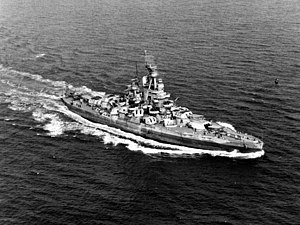Nevada-class battleship

USS Nevada after her 1942 reconstruction.
|
|
| Class overview | |
|---|---|
| Name: | Nevada-class battleship |
| Builders: |
|
| Operators: |
|
| Preceded by: | New York class |
| Succeeded by: | Pennsylvania class |
| Built: | 1912–1916 |
| In commission: | 1916–1946 |
| Completed: | 2 |
| Lost: | 1 |
| Retired: | 1 |
| General characteristics | |
| Type: | Battleship |
| Displacement: | Standard: 27,500 long tons (27,900 t) |
| Length: | 575 ft (175.3 m)(waterline); 583 ft (177.7 m) (overall) |
| Beam: | 85 ft 6 in (26.1 m) |
| Draft: | 28 ft 6 in (8.7 m) |
| Propulsion: |
|
| Speed: | 20.5 knots (38.0 km/h; 23.6 mph) |
| Range: |
|
| Complement: | (as built) 864 officers and men (from 1929) 1,398; (from 1945) 2,220; |
| Armament: |
|
| Armor: |
|
| Aircraft carried: |
|
| Notes: | 2,042 tons oil fuel |
The two Nevada-class battleships were the first Standard-type battleships produced by the U.S. Navy, and also the first to use triple main turrets. Nevada (BB-36) and Oklahoma (BB-37) were both ordered in March 1911. In armament, armor, and propulsion the Nevada class represented a considerable evolution in battleship design and, in being designed specifically to fight at extreme gunnery ranges, was actually well ahead of its time. They would be followed by the Pennsylvania-class battleships.
The standard type design was maintained until after WWI including the ship classes Pennsylvania, New Mexico, Tennessee and Colorado. All of these ships shared the following design features: four main turrets, "all or nothing" armor scheme including significant deck armor and completely oil-fired propulsion. This combination of features made the Nevadas the prototype of the modern battleship. For example, the protection of the standard class battleships was not significantly revised after the Battle of Jutland, while other Navies tended to have different pre- and post-Jutland designs.
Active in the Atlantic Ocean before and during World War I, the Nevadas were deployed to protect Allied supply lines in the European war zone in 1918. Their service continued after the "Great War", though by the early 1920s they were the oldest of the main Battle Fleet units. Both were extensively modernized between 1927 and 1929. Oklahoma was sunk during the attack on Pearl Harbor in 1941 and was a total loss. Nevada beached herself during this raid to prevent blocking the harbor entrance after receiving damage, and was salvaged and modernized. She provided gunfire support for amphibious operations in the European and Pacific theaters, which included shelling German shore batteries on D-Day along with USS Texas and USS Arkansas. Considered too old at the end of World War II to be kept in active service, Nevada was used as a target ship for nuclear and conventional weapons from 1946 to 1948, proving that her protection scheme was sound as she remained afloat for further target use after nuclear weapons tests in Operation Crossroads.
...
Wikipedia
